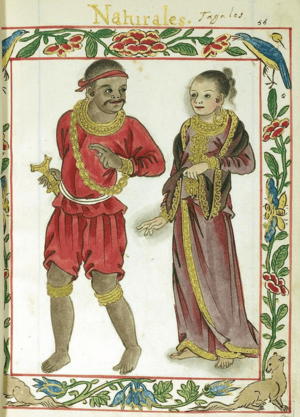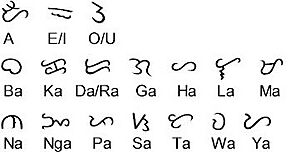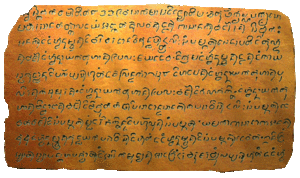History of the Philippines (900–1565) facts for kids
 |
|
| Horizon | Philippine history |
|---|---|
| Geographical range | Southeast Asia |
| Period | c. 900–1560s |
| Dates | c. Before 900 AD |
| Major sites | Tundun, Seludong, Pangasinan, Limestone tombs, Idjang citadels, Panay, Rajahnate of Cebu, Rajahnate of Butuan, Rajahnate of Sanmalan, Kota Wato, Kota Sug, Ma-i, Dapitan, Gold artifacts, Singhapala |
| Characteristics | Indianized Malay kingdoms, Hindu and Buddhist Nations, Malay Sultanates |
| Preceded by | Prehistory of the Philippines |
| Followed by | Colonial era |
The pre-colonial era of the Philippines covers the time from 900 AD until the Spanish arrived in 1565. This period began with the creation of the Laguna Copperplate Inscription in 900 AD. This important document helps us understand the history of the islands before Europeans arrived.
During this time, the Philippines was home to many different kingdoms and sultanates. These groups were connected to larger cultures in Southeast Asia, like the Indosphere (influenced by India) and the Sinosphere (influenced by China).
We learn about this time from several sources. These include old archeological findings and records from traders. We also have accounts from the Song dynasty in China, the Bruneian Sultanate, Korea, and Japan. Muslim traders also kept records. Spanish writers in the 16th and 17th centuries wrote about what they saw. Finally, old cultural traditions that were not changed by European influence also give us clues.
Contents
Life in Early Philippine Society
Early Philippine society had many different groups of people. Some were fishermen, farmers, or hunter-gatherers. Some lived in mountains, others on houseboats, and some in busy coastal towns. Some groups could provide for themselves, while others traded with nearby groups.
Historians often group these societies into four main types:
- Classless societies: Everyone was seen as equal, with no special social ranks.
- Warrior societies: People who were brave and skilled in battle had a special place in society.
- Petty plutocrats: In these groups, certain families had more wealth, usually from owning land. This wealth was passed down through generations.
- Principalities: These societies had a ruling class. Leaders inherited their power and had control over the community.
The Laguna Copperplate Inscription
The Laguna Copperplate Inscription (LCI) is the oldest written record found in the Philippines. It shows that people in the islands had a writing system very early on. The document is about 20 cm by 30 cm in size. It has ten lines of writing on one side.
What the Inscription Says
The LCI is mostly written in Old Malay. It also has words from Sanskrit, Old Javanese, and Old Tagalog. The writing uses the Kawi script. A Dutch expert, Antoon Postma, was able to read and understand the text.
The inscription is dated to the "Year of Saka 822," which means April–May in 900 AD. The text talks about a debt being cleared for the family of a person named Namwaran. This debt was for 926.4 grams of gold. The Military Commander of Tundun (Tondo) granted this freedom from debt. Leaders from places like Pailah, Binwangan, and Puliran witnessed it. These places were likely also in Luzon. The text also mentions the Medang Kingdom in Indonesia. This suggests that there were connections between these early Philippine groups and other kingdoms in Maritime Southeast Asia.
Early Kingdoms and Communities
Early settlements in the Philippines were called barangays. These were small communities, usually with 20 to 100 families along the coast. Inland areas had about 150–200 people. Coastal settlements often traded and connected by water. There was less contact between people in the mountains and those in the lowlands.
By the 1300s, some large coastal settlements became important trading centers. These places saw many changes in how society was organized. Some of these early Philippine groups even traded with other states across Asia.
Important Early Polities
Many kingdoms and sultanates formed in the Philippines between the 10th and 16th centuries. Some of these include Maynila, Tondo, Namayan, Pangasinan, Cebu, Butuan, Maguindanao, Lanao, Sulu, and Ma-i.
Leaders of these groups were called datus. They ruled their own independent barangay or dulohan. When several barangays joined together, a more respected datu would become a "paramount datu," rajah, or sultan. This leader would head the larger community or state.
Social Classes in Early Societies
Early Philippine societies often had three main social levels:
- Nobility: This was the ruling class, often called Datu or Maginoo. The datu was the main leader.
- Freemen: These were people who were not nobles but were free. The Maharlika were a warrior class, and the Timawa were common freemen.
- Dependent Class: These were people who owed service or labor. They were called Alipin. There were two types: aliping namamahay (who lived in their own homes) and aliping saguiguilid (who lived with their masters).
| Polity / Kingdom | Period | Today part of |
|---|---|---|
| Ijang | unknown – 1790 | Batanes |
| Igorot | unknown – 1902 | Cordillera, parts of La Union and Nueva Vizcaya |
| Lakanate of Lawan | c. 1800 BC | Samar, parts of Eastern Visayas |
| Samtoy | unknown – 1572 | Ilocos Region |
| Tondo | c. 900 – 1589 | Manila, parts of Central Luzon, Calabarzon and Bicol |
| Ma-i | c.971 – c. 1339 | Mindoro Island, parts of Southern Luzon |
| Rajahnate of Sanmalan | c. 982 – 1500s | Zamboanga |
| Sandao | c.1000 – c. 1300s | Calamian, Palawan, and parts of Luzon |
| Rajahnate of Butuan | c. 989 – 1521 | Butuan, parts of Northern Mindanao and Caraga |
| Cainta | unknown – 1571 | Cainta |
| Kedatuan of Mairete | unknown – 1569 | parts of Northern Leyte |
| Kedatuan of Dapitan | unknown – 1595 | Bohol, parts of Northern Mindanao |
| Kedatuan of Madja-as | c. 1082 – 1569 | Western Visayas |
| Namayan | 1175–1571 | Manila, parts of Calabarzon |
| Kumintáng | unknown – 1572 | Batangas |
| Pulilu | unknown – 1571 | Polillo, Quezon |
| Ibalon | unknown – 1573 | Bicol Region |
| Taytay | c. 1300 – 1623 | Northern Palawan |
| Rajahnate of Sugbu | 1400–1565 | Cebu, parts of Central Visayas |
| Sultanate of Sulu | 1405–1915 | Sulu Archipelago, parts of Southern Palawan, Sabah, North and East Kalimantan in north-eastern Borneo |
| Caboloan | c. 1406 – 1576 | Pangasinan, parts of Northern Luzon |
| Maynila | 1500–1571 | Manila, parts of Central Luzon |
| Sultanate of Maguindanao | 1520–1928 | Maguindanao, parts of Bangsamoro, Zamboanga Peninsula, Northern Mindanao, Soccsksargen and Davao Region |
| Sultanates of Lanao | 1520 – Present | Lanao, parts of Bangsamoro |
Trade with Other Countries
Trade with China likely started during the Tang dynasty (618–907 AD). It grew much larger during the Song dynasty (960–1279 AD). By the 1000s, some Philippine groups sent trade groups to China. They traded goods but were not under China's political control.
People in the islands highly valued jars, which were a sign of wealth. Later, they also valued metal, salt, and tobacco. In return, they traded things like feathers, rhino horns, hornbill beaks, beeswax, bird's-nests, resin, and rattan.
Indian Influence on Culture
Indian culture, including words and religious practices, began to spread in the Philippines around the 10th century. This likely happened through the Hindu Majapahit empire, which was powerful in Southeast Asia.
Writing Systems
Indian writing systems, called Brahmic scripts, influenced the Kawi script. They also led to the creation of several native writing systems in the Philippines. The Laguna Copperplate Inscription was written using the Kawi script.
Baybayin Script

By the 13th or 14th century, the baybayin script was used for the Tagalog language. It spread to Luzon, Mindoro, Palawan, Panay, and Leyte. However, there is no evidence it was used in Mindanao.
There were at least three different versions of baybayin in the late 1500s. These were like different styles of writing, similar to how different versions of Latin might have slightly different letters or spelling.
In 1521, a writer named Antonio Pigafetta traveled with Ferdinand Magellan. He noted that the people they met in the Visayas could not read or write. But in the next few decades, the Baybayin script seemed to reach them. In 1567, Miguel López de Legaspi reported that the Visayans "have their letters and characters like those of the Malays." He said they wrote on bamboo and palm leaves. However, he noted that they didn't have old written records of their history. Their customs were passed down through stories from parents to children.
First Contact with China
The earliest direct contact between China and the Philippines is thought to be in 982 AD. At that time, traders from "Ma-i" (likely in Mindoro or Laguna de Bay) brought their goods to Chinese cities like Guangzhou and Quanzhou. This is mentioned in old Chinese historical texts.
The Arrival of Islam

How Islam Began to Spread
Muslim traders brought Islam to the islands around the time the Majapahit Empire had internal conflicts, around 1405. However, by 1380, a person named Makhdum Karim had already brought Islam to the Philippines. He built the Sheik Karimal Makdum Mosque in Simunul, Tawi-Tawi, which is the oldest mosque in the country.
By the 15th century, Islam was strong in the Sulu Archipelago. From there, it spread further into the islands. Later, visits from Arab, Malay, and Javanese missionaries helped Islam grow even more.
The Sultanate of Sulu was a powerful Muslim kingdom. It once included parts of modern-day Indonesia, Malaysia, and the Philippines. Its royal family claims to be related to Muhammad, the founder of Islam.
Bruneian Attacks
In the early 1500s, the Bruneian Empire was very strong. Its leader, Sultan Bolkiah, attacked the Kingdom of Tondo in Luzon.
Spanish Expeditions to the Philippines
The table below shows the Spanish expeditions that reached the Philippine islands.
| Year | Leader | Ships | Landing |
|---|---|---|---|
| 1521 | Trinidad, San Antonio, Concepcion, Santiago and Victoria | Homonhon, Limasawa, Cebu | |
| 1525 | García Jofre de Loaísa | Santa María de la Victoria, Espiritu Santo, Anunciada, San Gabriel, Jayson Ponce, Santa María del Parral, San Lesmes and Santiago | Surigao, Visayas, Mindanao |
| 1527 | 3 unknown ships | Mindanao | |
| 1542 | Santiago, Jorge, San Antonio, San Cristóbal, San Martín, and San Juan | Samar, Leyte, Saranggani | |
| 1564 | San Pedro, San Pablo, San Juan and San Lucas | first landed on Samar, established colonies as part of Spanish Empire |
Magellan's First Expedition (1521)
The first European expedition to the Philippines was led by the Portuguese explorer Ferdinand Magellan in 1521. He was sailing for King Charles I of Spain.
Magellan's ships first saw the mountains of Samar on March 17, 1521. The next day, they landed on the small, uninhabited island of Homonhon. On Easter Sunday, March 31, 1521, on the island of Mazaua, Magellan placed a cross on a hill. He claimed the islands for the King of Spain and named them Archipelago of Saint Lazarus. This was written by his travel companion, Antonio Pigafetta.
Magellan tried to make friends with the local leaders. He started with Datu Zula of Sugbu (Cebu). Magellan was very proud of converting them to Christianity. He also got involved in local conflicts. He joined Datu Zula in a battle against Lapulapu, the chief of Mactan, who was Datu Zula's enemy.
On April 27, 1521, Magellan and 60 armed men, along with 1,000 Visayan warriors, tried to land on Mactan. Lapulapu had 1,500 warriors waiting. Magellan went ashore with his soldiers, telling Datu Zula and his men to stay on the ships. Magellan had underestimated Lapulapu's army. Magellan and 14 of his soldiers were killed because they were greatly outnumbered. The rest managed to get back to their ships.
After this battle, the expedition had too few crew members for three ships. So, they left the ship "Concepción" behind. The remaining ships, "Trinidad" and "Victoria", sailed to the Spice Islands (in modern-day Indonesia). From there, the expedition split. The Trinidad tried to sail back across the Pacific Ocean to Panama. But many crew members died from disease and the ship was damaged. The survivors were captured by the Portuguese. The Victoria, led by Juan Sebastián Elcano, continued sailing west. It successfully returned to Spain in 1522, completing the first trip around the world.
Later Spanish Expeditions
After Magellan's journey, four more Spanish expeditions came to the islands. These were led by García Jofre de Loaísa (1525), Sebastian Cabot (1526), Álvaro de Saavedra Cerón (1527), and Ruy López de Villalobos (1542).
In 1543, Villalobos named the islands of Leyte and Samar Las Islas Filipinas. He did this to honor Philip II of Spain, who was then the Prince of Asturias.
The Spanish Conquest Begins
Philip II became King of Spain in 1556. In 1559, he ordered another expedition. Its real goal was to conquer the Philippine islands.
On November 19 or 20, 1564, a Spanish expedition of about 500 men, led by Miguel López de Legazpi, left Mexico. They arrived in Cebu on February 13, 1565. This expedition set up the first Spanish settlements in the Philippines. It also led to the discovery of a return route across the Pacific to Mexico. This route was called the tornaviaje and was found by Andrés de Urdaneta. This discovery started the Manila galleon trade, which lasted for 250 years.
Images for kids
-
Depiction of a noble Visayan couple in the 16th-century (Boxer Codex)
See also
 In Spanish: Filipinas prehispánica para niños
In Spanish: Filipinas prehispánica para niños
- Anito
- Antonio de Morga
- Antonio Pigafetta
- Barangay (pre-colonial)
- Baybayin
- Boxer Codex
- Butuan (historical polity)
- Cainta (historical polity)
- Caboloan
- Dambana
- Datu
- Enrique of Malacca
- Ferdinand Magellan
- First Mass in the Philippines
- Tondo (historical polity)
- Lacandola Documents
- Lakan
- Lapulapu
- List of sovereign state leaders in the Philippines
- Luzones
- Ma-i
- Madja-as
- Maginoo
- Maharlika
- Maynila (historical polity)
- Philippine shamans
- Pintados
- Pulilu
- Rajah
- Rajah Humabon
- Rajahnate of Butuan
- Rajahnate of Cebu
- Sandao
- Sanmalan
- Sultanate of Maguindanao
- Sultanate of Sulu
- Suyat
- Thimuay
- Timawa
- Warfare in pre-colonial Philippines
- Tawalisi
- Use of gold in early Philippine history
- History of the Philippines
- Prehistory of the Philippines
- History of the Philippines (Spanish Era 1521–1898)
- History of the Philippines (American Era 1898–1946)
- History of the Philippines (Third Republic 1946–65)
- History of the Philippines (Marcos Era 1965–86)
- History of the Philippines (Contemporary Era 1986–present)





